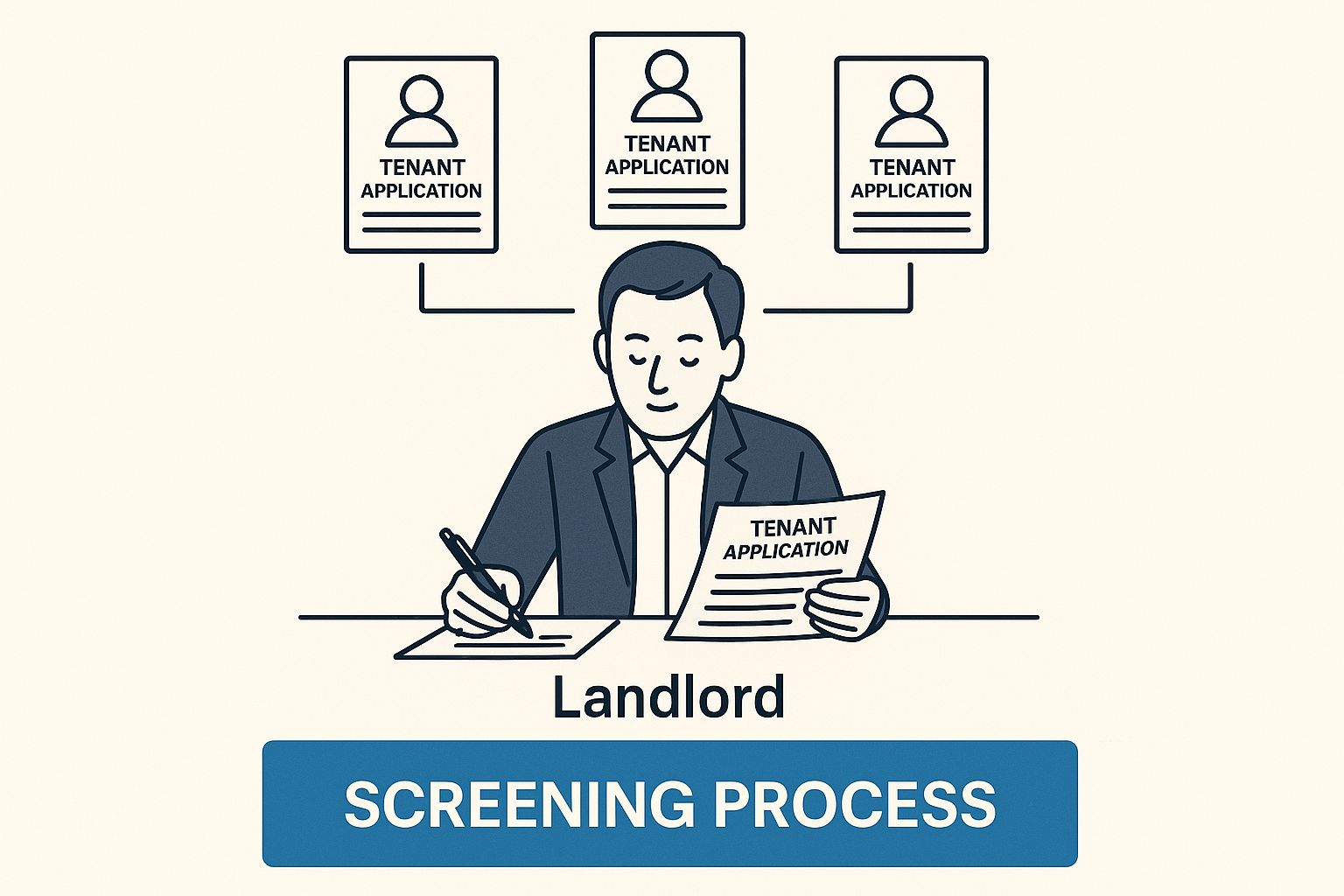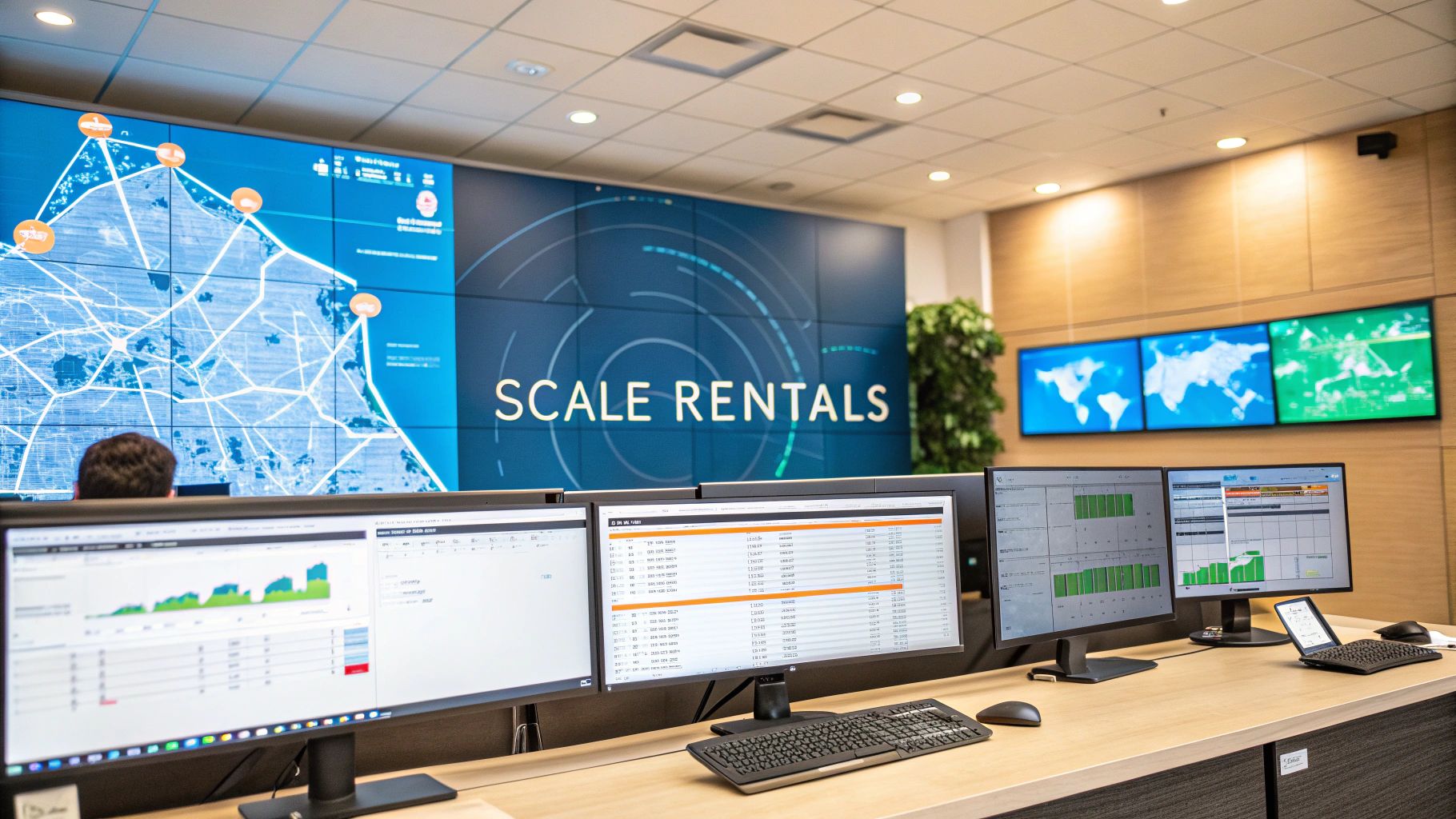When you’re managing a portfolio of 100 to 10,000+ rental units, the game changes entirely. It's no longer about individual tasks like collecting rent; it's about engineering a high-performance, tech-driven operational engine designed for ruthless efficiency and scalability. The manual, one-off processes that work for smaller portfolios become liabilities that drain revenue and stifle growth.
This is the shift to enterprise rental property management: leaving behind localized, hands-on tasks and embracing centralized, automated systems built to optimize every dollar and every day across your entire asset base.
What Is Modern Rental Property Management at Scale

At its core, managing a large, distributed portfolio is about creating a scalable engine that standardizes everything—from lead-to-lease velocity and maintenance workflows to compliance protocols and financial reporting. It’s a complete departure from the old-school methods that collapse into chaos and unprofitability when applied to hundreds or thousands of doors, especially in remote property management operations without onsite staff.
This modern approach elevates operational efficiency from a line item to the primary driver of profitability. For enterprise-level operators, every decision is measured against key performance indicators (KPIs) that directly impact the bottom line. It demands a systemized, data-first mindset where speed-to-lease and cost-per-door are paramount.
Shifting Focus from Tasks to Revenue-Driving Metrics
The most significant distinction between managing a few properties and a massive portfolio is the obsession with metrics. A small landlord focuses on filling one unit. An enterprise property manager analyzes the collective performance of their entire asset base to identify opportunities for systemic improvement.
These are the numbers that truly matter to large-scale operations:
- Days on Market (DOM): Every vacant day is a direct revenue loss. For a 1,000-unit portfolio with an average rent of $2,000, each day of vacancy costs approximately $66,667 in lost revenue. A 5-day DOM reduction across that portfolio could recapture over $330,000 annually.
- Lead-to-Tour Conversion Rate: This KPI measures the efficiency of your top-of-funnel leasing operations. A low conversion rate indicates friction is preventing qualified leads from seeing properties, directly extending vacancy periods and increasing marketing costs.
- Cost Per Door: This metric breaks down all operational expenses on a per-unit basis. It is crucial for identifying inefficiencies in maintenance, marketing, and administrative workflows, providing a clear path to profitable scaling.
Building a Scalable Operational Engine for Remote Portfolios
Achieving superior performance on these metrics is impossible without a rock-solid operational framework. For multi-market portfolios—especially those without onsite staff—that framework must be built on centralized control and property management automation. The goal is to create a system where leasing inquiries, maintenance requests, and tenant communications all flow through a standardized, repeatable, and automated process.
A scalable management engine eliminates operational guesswork. It empowers your team to focus on high-value strategic initiatives and asset performance instead of being bogged down in manual coordination. It's the only viable path to delivering consistent quality and financial returns across a geographically dispersed portfolio.
This systematic approach is defining the future of property management, where technology is no longer an add-on but the central nervous system of the entire enterprise. By engineering this engine, property management companies can transcend maintenance and begin optimizing their portfolios for long-term, scalable growth.
The Four Pillars of Enterprise Property Management
Managing a massive rental portfolio is akin to running four distinct, interconnected businesses. For enterprise-level operators, successful rental property management boils down to achieving mastery across four core pillars. A bottleneck in one area creates a drag on the entire operation.
Think of them as the load-bearing columns supporting your portfolio's financial health. A slow leasing process directly impacts revenue, while inefficient maintenance leads to tenant dissatisfaction and compliance risks. Building a resilient, profitable, and scalable operation requires excellence in all four.
The infographic below highlights a critical component of the leasing pillar: tenant screening. This isn’t just administrative work; it’s the quality control gateway that protects your assets and financial stability by ensuring reliable residents.

A rigorous, systematic screening process directly impacts the cash flow and long-term performance of every single unit under management.
Here’s a breakdown of how these pillars support a large-scale operation, including the key activities and performance indicators that matter most at an enterprise level.
Four Pillars of Enterprise Property Management
Each pillar requires its own specialized strategy and technology, but they are deeply codependent. Strong financial performance hinges on rapid leasing, which in turn relies on well-maintained properties and airtight compliance to prevent costly legal disputes.
Financial Management at Scale
For large portfolios, financial management transcends simple rent collection. It is a strategic discipline focused on maximizing revenue per unit while rigorously controlling costs. The primary objective is to drive Net Operating Income (NOI) growth across thousands of doors, which demands a granular, real-time understanding of your financials.
This means a constant focus on:
- Budgeting and Forecasting: Creating detailed, portfolio-wide budgets and tracking performance against projections to proactively identify and address variances.
- Cost Per Door Analysis: Obsessively breaking down and optimizing every expense category—from marketing to maintenance—on a per-unit basis to uncover scalable savings.
- Revenue Optimization: Leveraging dynamic pricing tools and market data to set rental rates that optimize the balance between minimizing vacancy and maximizing income.
Leasing and Tenant Management
Leasing is your portfolio’s revenue engine. At scale, it cannot be a manual, high-touch process; it must function like an automated machine obsessed with one goal: speed-to-lease. Every day a property sits vacant, you are losing revenue, and that loss compounds exponentially across a large portfolio.
For a 1,000-unit portfolio with an average rent of $2,000 per month, a single additional day of vacancy costs the business nearly $67,000 in lost potential revenue. This is precisely why Days on Market (DOM) is the metric that defines success for large-scale operators.
This is where property management automation becomes essential. The objective is to move qualified prospects from initial inquiry to a signed lease with maximum velocity and minimal human intervention. This requires automated lead nurturing, self-service tour scheduling, and a frictionless online application process designed to secure high-quality tenants before competitors can.
Property Maintenance Systems
Managing maintenance across a geographically dispersed portfolio is a major logistical challenge and a significant cost center. The key to profitability is shifting from a reactive, "break-fix" model to a proactive, preventative system managed from a central command center, especially for portfolios without onsite staff.
A robust system typically includes:
- A centralized work order platform integrated with your core Property Management System (PMS).
- A pre-vetted, performance-managed network of vendors for every market.
- Standardized Service Level Agreements (SLAs) to ensure work is completed to quality standards, on time, and within budget.
Legal and Regulatory Compliance
Finally, as a portfolio grows, so does its exposure to legal and regulatory risk. A minor compliance misstep—whether related to fair housing laws, lease language, or local ordinances—is amplified across thousands of units, creating significant financial and reputational liability.
Technology is the most effective defense. By using software to enforce standardized, compliant workflows for every process from marketing a listing to handling a security deposit, you ensure every team member adheres to the rules, every time. This systematic approach protects the business from costly litigation and maintains brand integrity across all markets.
Overcoming the Hurdles of Large Portfolio Management

As a rental portfolio scales, challenges don't just add up—they multiply exponentially. The manual systems that were adequate for 50 or 100 units begin to fracture under the weight of managing several hundred, or thousands, of properties. This is where the critical pain points of scaling rental property management emerge, keeping operations directors and portfolio managers awake at night.
The primary hurdle is logistics. Managing a geographically dispersed portfolio without dedicated onsite staff can become a nightmare of coordination. Simple tasks like scheduling showings, conducting inspections, and overseeing maintenance devolve into a chaotic web of phone calls, spreadsheets, and emails. This isn't just inefficient; it’s a direct path to costly errors that erode your bottom line.
The Struggle for Consistency and Control in Multi-Market Operations
Maintaining service quality and operational consistency across different markets is a massive challenge for remote property management operations. How do you guarantee a prospective tenant in Phoenix receives the same professional, high-velocity leasing experience as one in Atlanta? Without centralized, tech-enforced systems, enforcing standards is nearly impossible, leading to fragmented operations and an inconsistent brand experience.
This lack of standardization creates significant business risks:
- Inconsistent Tenant Screening: Disparate processes can lead to varying qualification criteria, dramatically increasing the risk of placing unqualified tenants.
- Variable Maintenance Response Times: Without a unified work order system, tenant satisfaction plummets as response times vary wildly between locations.
- Compliance Risks: Local and state regulations differ significantly. A decentralized approach makes it incredibly difficult to ensure portfolio-wide compliance, exposing the business to severe legal and financial penalties.
The core issue is a loss of control. When processes are not standardized and enforced through technology, each market operates as an independent silo, making portfolio-level performance optimization an impossible task.
Managing a large portfolio requires proactive risk mitigation. A key example is having a robust emergency response plan. Understanding the key insights into emergency water damage prevention and restoration for property managers can save your portfolio significant time and money when unforeseen events occur.
The Financial Impact of Operational Drag
Ultimately, these operational inefficiencies translate directly into lost revenue. The most significant financial drain is vacancy. Every day a unit remains empty is a day of lost income, and at scale, the financial impact is staggering.
Let's calculate the real cost. For a portfolio of 1,000 units with an average rent of $2,000, a single day of vacancy across the portfolio costs $66,667 in potential revenue. Shaving just two days off your average Days on Market (DOM) would inject an additional $133,334 into your monthly revenue. The immense pressure to lease units faster while controlling operational costs is why manual processes are no longer viable for enterprise-level property management companies.
The national average rental vacancy rate was 6.6% in the first quarter of 2024, but this figure masks the intense competition within specific submarkets. With rising operational costs and fierce competition, tech-driven efficiency is no longer a luxury—it is a requirement for survival and profitability. It's time to transition from manual coordination to automated, scalable solutions that solve the core challenges of large-scale rental property management.
Building Your Tech Stack for Scalable Operations
Attempting to scale a large rental portfolio with manual processes is like trying to win a Formula 1 race on a bicycle. Technology is the engine that powers modern, large-scale rental property management, and architecting the right tech stack is the key to achieving market-leading performance.
Your Property Management System (PMS) serves as the central operating system. It houses the core data on properties, tenants, and financials. However, the real competitive advantage comes from integrating specialized, API-driven tools that automate critical functions and feed real-time data back to the core system, creating a powerful, interconnected operational ecosystem.
The Core Components of an Enterprise Tech Stack
Building a high-performance tech stack is about strategic integration, not software collection. It involves selecting best-in-class tools that solve specific, high-impact problems for large-scale operators. The essentials include:
- Property Management System (PMS): The non-negotiable foundation (e.g., AppFolio, Yardi, RentManager). It serves as the single source of truth for all property, tenant, and financial data.
- Leasing Automation & CRM: The primary weapon against revenue-killing Days on Market (DOM). These platforms automate the entire leasing funnel, from initial lead response and self-service tour scheduling to application and lease signing.
- Maintenance & Work Order Management: Essential for managing a distributed portfolio without onsite staff. These tools streamline maintenance requests, vendor dispatch, and job tracking to control costs and maintain tenant satisfaction.
- Accounting & Financial Reporting: While most PMS platforms offer robust accounting, large enterprises often require specialized software for advanced portfolio analysis, sophisticated budgeting, and customized investor reporting.
- Smart Home & Access Control: Devices like smart locks and thermostats are no longer just amenities. They provide secure, remote access for self-showings and vendor work, reduce utility costs during vacancies, and serve as a premium feature to command higher rent.
Integrating smart home technology can significantly enhance operational efficiency and resident experience. It is worth exploring the benefits of smart thermostats for their impact on remote energy management and cost control alone.
Attacking Days on Market with Leasing Automation
For the highest and fastest return on technology investment, focus on leasing automation. Every manual step in the leasing process is a point of friction that introduces delays, increases vacancy loss, and drives up cost-per-lease.
This is where dedicated automated leasing software delivers transformative results. Manual processes simply cannot compete with the speed and efficiency of an automated system, especially when managing a high volume of leads across multiple markets.
Let's compare a traditional workflow to an automated one to see the impact on key metrics.
Manual vs. Automated Leasing Workflows at Scale
This represents a fundamental operational shift from manual coordination to automated execution. It directly addresses the single greatest challenge for large portfolios: speed-to-lease. By providing prospects with instant, on-demand, self-service options, platforms like Showdigs convert interested leads into signed leases at a velocity that traditional processes cannot match, delivering an immediate and measurable impact on your revenue.
Integration is the Key to a Single Source of Truth
A collection of disconnected software tools creates data silos and operational chaos. The true power of an enterprise tech stack is realized through seamless API integrations, enabling automated data flow between all systems.
An effective tech stack demolishes data silos. When your leasing CRM, maintenance platform, and accounting software are all communicating with your central PMS, you establish a single source of truth. This ensures every team member operates from the same accurate, real-time information—a non-negotiable for making intelligent, data-driven decisions at scale.
For operations directors and portfolio managers, this means an end to juggling multiple spreadsheets and reconciling conflicting reports. You gain a clean, holistic, real-time view of your entire portfolio's performance. For guidance on selecting the right system, our guide on the best leasing CRMs for your property management business is an excellent resource. This integrated approach is the only way to achieve true operational excellence during periods of rapid growth.
Turning Best Practices Into Profitable Growth
Deploying a best-in-class tech stack is the first step. Translating that technology into measurable financial returns requires a disciplined operational framework. To truly scale your rental property management enterprise, you must implement a strategic plan that transforms technology into profit through a culture of data-driven decision-making, rigorous process standardization, and an agile workforce.
This transformation begins with a relentless focus on the key performance indicators (KPIs) that directly drive revenue and control costs. It means moving beyond surface-level metrics like occupancy rates to analyze the underlying drivers of leasing funnel health and operational efficiency.
Build a Culture Around Data-Driven Decisions
A data-first culture means every strategic decision is backed by quantitative evidence. Instead of speculating about underperformance, you diagnose the root cause by analyzing the data. This requires tracking and scrutinizing core metrics across the entire portfolio without exception.
The KPIs that enterprise leaders must monitor relentlessly include:
- Cost-Per-Lease: The all-in cost to fill a vacancy, including marketing spend, agent commissions, and administrative overhead. Reducing this metric is fundamental to profitable growth.
- Vacancy Loss: The daily revenue lost for every empty unit. This powerful metric quantifies the financial urgency of a high-velocity leasing process.
- Lead-to-Tour Conversion Rate: This KPI measures your effectiveness at converting initial interest into property tours. A low rate signals friction in your leasing process that is losing qualified leads.
By visualizing these KPIs on dashboards and making them a central topic in team meetings, you create a culture of performance and accountability. Every team member understands how their daily activities directly impact the company's financial success.
Standardize Everything with Operating Procedures
Consistency is the bedrock of scalability. Standardized Operating Procedures (SOPs) are the operational playbook for your enterprise—detailed, documented guides for executing every repeatable task with maximum efficiency and compliance. They eliminate ambiguity and ensure every team member, in every market, operates in unison.
Think of SOPs as your operational blueprint. They guarantee that an agent in Dallas follows the exact same tech-enforced steps as an agent in Denver to qualify a lead, schedule a tour, or process an application. That consistency is what enables quality control at scale.
Focus on documenting high-impact processes first: lead management, tour scheduling, tenant screening, and rent collection. Utilize simple flowcharts and checklists, and embed these workflows directly into your property management software to ensure adoption and adherence.
Get Agile with a Hybrid Workforce
The final component of a scalable operating model is an agile, cost-effective team structured for a distributed portfolio. For most rapidly growing operators, a hybrid model that combines a core remote team with a flexible, on-demand network of field agents is the most effective solution.
This hybrid structure offers compelling advantages:
- Centralize Your Core: A remote team handles centralized administrative functions—lead nurturing, application processing, tenant communications—from a single hub, minimizing overhead.
- Deploy On-Demand Field Agents: Leverage a network of licensed field agents, like the one from Showdigs, for on-the-ground tasks like property showings and move-in inspections. This provides "boots on the ground" capabilities without the fixed cost of full-time employees in every market.
This hybrid model creates a lean, adaptable operational machine. It converts fixed labor costs into variable expenses, allowing you to scale field capacity up or down in response to market demand without the financial burden of a large payroll. When this agile workforce is combined with a data-driven culture and ironclad SOPs, you have engineered a powerful engine for profitable growth.
The Future of AI in Rental Property Management
The next evolutionary leap in rental property management is here, and it is powered by Artificial Intelligence. For enterprise operators focused on scaling operations and maximizing NOI, AI has transitioned from a future concept to an essential component of a competitive tech stack. This is not a distant trend; it is actively reshaping how the most successful firms manage their portfolios today.
The property management market is experiencing significant growth, with the U.S. sector projected to reach $98.88 billion by 2029. This expansion is fueled by technology that enables scalable growth. The 304,000+ property management businesses in the U.S. are rapidly discovering that AI is critical for managing more doors, more profitably. You can explore the key statistics shaping the property management industry for a comprehensive overview.
Predictive Analytics and Proactive Operations
One of AI's most powerful applications is its ability to forecast operational issues before they escalate into costly emergencies. By analyzing historical repair data, utility usage patterns, and even weather forecasts, AI can identify assets at high risk of failure—for instance, flagging an HVAC unit for inspection just before a summer heatwave.
This enables a strategic shift from reactive to proactive maintenance. Instead of absorbing the high cost and tenant frustration of an after-hours emergency repair, you can schedule preventative service during business hours. This simple change can save thousands per incident and significantly improve resident satisfaction.
Dynamic Pricing and Tenant Retention
AI is also revolutionizing financial strategy. Smart algorithms continuously analyze real-time market data, competitor pricing, and local demand trends to recommend optimal rental rates. This dynamic pricing ensures you maximize revenue from every unit without overpricing your inventory, directly boosting your Net Operating Income (NOI).
Beyond pricing, AI can enhance tenant retention. By analyzing communication patterns and payment histories, AI models can identify residents at risk of non-renewal. This provides your team with an early warning to proactively engage with a renewal offer or address service issues, thereby preventing costly turnover. To see this technology in action, learn about the benefits of using an AI leasing assistant.
The true value of AI in property management lies in its ability to convert vast amounts of data into actionable, revenue-generating insights. It enables faster, more intelligent decisions across every facet of the business, from maintenance and pricing to leasing and resident experience.
Enhanced Tenant Experience
Finally, AI is elevating the tenant experience. AI-powered chatbots provide instant, 24/7 answers to common resident questions, freeing up your human team to handle more complex, high-touch issues. Automated systems can manage routine tasks like scheduling maintenance or processing rent payments, delivering the seamless, on-demand service that modern renters expect.
The conclusion is clear: the property management firms that will dominate the future are those that integrate AI and automation into the core of their operations. This is no longer an optional upgrade—it is a prerequisite for building a smarter, more efficient, and scalable business.
Common Questions from Growing Teams
As you scale your rental portfolio, several critical questions consistently arise. Here are the answers to the most common challenges faced by operations directors and portfolio managers.
What’s the Single Most Important Metric to Track?
While Net Operating Income (NOI) is the ultimate measure of portfolio profitability, the most sophisticated operators focus intensely on the leading indicators that drive it. Without question, the most critical operational metric is Days on Market (DOM). Every vacant day represents a direct, unrecoverable revenue loss.
Reducing your DOM by just a few days across a thousand-unit portfolio can add hundreds of thousands of dollars in annual revenue. Other vital metrics, such as your lead-to-tour conversion rate, are a close second; they provide a clear diagnosis of your leasing funnel's health and efficiency.
How Can We Standardize Operations Across Different Cities?
True standardization is achieved not through manuals, but through systems that enforce consistency. The foundation is a centralized tech stack and meticulously documented Standard Operating Procedures (SOPs). The first step is to consolidate all operations onto a single Property Management System (PMS) to serve as your single source of truth.
From there, you integrate best-in-class tools for critical functions like leasing automation and maintenance management. By documenting every workflow and embedding it within your technology, you ensure every team member, regardless of location, follows the exact same efficient and compliant process—every time.
What's the Best First Step for Leasing Automation?
Before investing in any software, conduct a thorough audit of your current leasing process to identify the single biggest bottleneck. Map the entire journey from initial inquiry to signed lease.
Where is the friction costing you leads and time? Is it the delay in initial response? The back-and-forth emails to schedule a viewing? For most large portfolios, the most significant point of failure is the time lag between a prospect's initial interest and the moment they can physically tour a property.
This is why implementing a solution focused on instant, on-demand, and self-service tour scheduling almost always delivers the highest and fastest ROI. It directly solves the core problem of speed-to-lease, accelerating the entire leasing cycle and driving down Days on Market. This single strategic move can have a massive and immediate impact on your revenue by converting qualified leads into signed leases faster than any manual process ever could.
Ready to slash your Days on Market and optimize your lead-to-tour conversion rate? Showdigs combines AI-powered leasing automation with an on-demand network of licensed agents to turn leads into leases with unparalleled speed. Book a demo today to see how you can build a leaner, more profitable leasing operation at scale.







